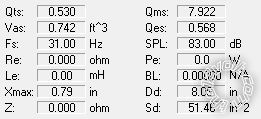I've been playing around with WinISD for a while now and I have a few manually entered subwoofers in the program now. What I've noticed is that to produce the best flat response (keeping around .707), most of the suggested air-space volume doesn't match manufacturer recommendations. Is this typical? Should I stick to manufacturer suggested air-space or would I get better results following WinISD?
For example, I plugged in the Alpine SWR-1043D into WinISD. I know WinISD is tricky and it likes to go out three decimal places, but I put in enough parameters and played with a few until all specs match Alpine's parameters (according to the sub's manual) when all numbers are rounded to the nearest decimal. Here's what I have in WinISD for the Alpine:

The above matches very well to the Alpine sub manual yet WinISD recommends air-space of .928 ft^3 for a sealed inclosure - which means about a 1.0 ft^3 box when accounting for the sub displacing about .08 ft^3 (as per its manual). Alpine's manual recommends a net internal volume of 0.5 ft^3.
What do you think would be best - stick with Alpine recommended or go with WinISD? I just want a sealed box that produces good quality bass - not looking for SPL and not dB dragging.
Thanks
-------------
Rob
Btw, if anyone is wondering, yes I DID do a search. I've found responses like "WinISD is more accurate and manufacturer only suggests "safe" solutions.." and also "manufacturer knows their products better and would want to extend the best possible recommendation to show-off their product".
Basically the searches can produce contradictary results. And I've not only searched this site but Google'd the crap out of it. I thought 12volt would be the best place to get a good answer from those who've actually trialed and errored.
-------------
Rob
In general, WinISD will create a model that satisfies whatever parameters you input. You can model for any system Q you like, etc. Manufacturers tend to suggest alignments they think will "sound good" to the majority of users out there. They may or may not design for a system Q that you might like. They tend to shoot for the widest possible acceptance for the type of user they think buys their drivers. One interesting thing to do is input the design parameters from the MFG and see how they model in something like WnISD... then make up your own mind. :)
-------------
Support the12volt.com